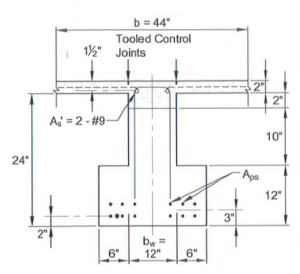KimWT said:
Any opinion from precast specialty engineers?
Yo! Precaster here, but full disclosure is I've never had to design a inverted tee yet in practice.
Precasters for some reason hate hoops and stirrups, likely because it's more time consuming for the shop guys to bend and form up so straight bars are always being asked of me. I try to accommodate them where possible.
But for this ACI 318-14 25.7.1.2 and 25.7.1.3 is pretty clear. Per the commentary, straight deformed bar and wire anchorage is not permitted. The
only exception is "joists". I highly doubt that you can call a inverted tee a "joist".
I did a pretty extensive google search and all the research and details I can find point to closed hoops or traditional stirrups.
The PCI Design Handbook is a little vague on this but does show similar details to yours in a number of places.
That said, I interpret the un-hooked bars they show as being intended as horizontal shear reinforcement for a composite topping. PCI also notes that the hanger reinforcement for the ledge is in addition to the shear reinforcement for the beam. Are they perhaps mixing closed stirrups or hoops in with those straight anchored bars in your girder?
The PCI handbook example and equations for calculating reinforcement for ledge attachment to the web isn't quite clear on this. There's a factor γ
t that states: "If closed stirrups are provided in the ledge, γ
t may conservatively be taken as 1.0. If closed stirrups are not provided in the ledge, γ
t may be taken as zero." However, they don't indicate if the closed stirrups they're referring to are the ledge reinforcement for torsion in the ledge, or the ledge attachment to the web (the bars your detail shows as not hooked around long. rebar).
Regardless, ACI controls and seems clear to me on what they require.
If anyone has a copy of these papers (I don't) it might shed some light on this:
[URL unfurl="true"]http://ascelibrary.org/doi/abs/10.1061/(ASCE)0733-9445(1983)109%3A8(1836)[/url]
[URL unfurl="true"]https://www.concrete.org/publications/internationalconcreteabstractsportal/m/details/id/10850[/url]
Professional Engineer (ME, NH, MA) Structural Engineer (IL)
American Concrete Industries


